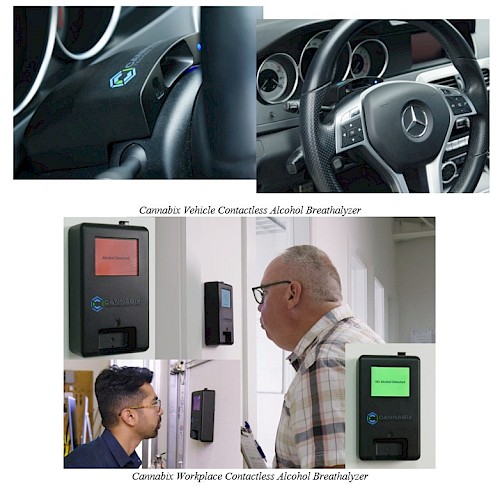News Releases
Cannabix Technologies Creates Contactless Alcohol Breath Detection Technology for Workplace and Vehicles – New Video
October 17, 2022
Vancouver, British Columbia, October 17, 2022 -- Cannabix Technologies Inc. (CSE: BLO) (OTC PINK: BLOZF) (the “Company or Cannabix”) developer of breath testing devices for law enforcement and the workplace reports that the Company has developed a cutting-edge Contactless Alcohol Breathalyzer for workplaces and vehicles. Cannabix engineers have developed a suite of Contactless Alcohol Breathalyzer (“CAB”) offerings that include a wall-mounted and in-vehicle (behind the steering column) versions. Cannabix has used its years of experience in breath testing and breath capture technology to rapidly develop its CAB advanced prototypes for a host of applications to increase safety. The Company has posted a video on its new CAB technology available for viewing at its website (link). The Company is seeking potential partners to commercialize its CAB technology.

The wall mounted CAB would be targeted for employers needing to deploy a pre-access test for alcohol consumption before and during work hours in a fast and cost-effective way. The CAB technology allows for a user to direct a single breath sample towards a small orifice integrated into a wall mounted unit (for indoor use) and behind the steering wheel for in-cabin vehicle use – in a completely contactless manner. The CAB is fundamentally different than existing alcohol breathalyzers and interlock systems that require users to use a mouthpiece or straw and directly blow into a handheld device that is connected to the vehicle usually with a cable. The Cannabix CAB could be integrated into various locations in the vehicle cabin. The CAB provides a warning, pass or fail result along with a Blood Alcohol Content (BAC) level on the screen for the driver to see. This kind of technology holds potential to be integrated with interlock systems and be used in various settings including automotive, heavy-duty equipment, heavy transport vehicles, watercraft and motorbikes. Furthermore, the device could be used in bars, restaurants and hotels for both patrons and employees.
Vehicle Alcohol Breath Screening
The Company has developed its CAB technology in response to interest in new vehicle alcohol detection technologies. In September, the National Transportation Safety Board (NTSB) issued a recommendation that all new vehicles be equipped with technology that would prevent a person impaired by alcohol from driving (1). In November 2021, the U.S. House of Representatives, passed the Infrastructure Investment and Jobs Act (IIJA) which called for new cars to come equipped with technology that will detect alcohol in breath. The legislation directs the National Highway Traffic Safety Administration to set new safety standards within three years for impaired driving safety equipment on all new vehicles (2) (3).
Manufacturers such as Volvo have experimented with offering alcohol-detection systems as optional equipment.
(1) https://www.ntsb.gov/news/press-releases/Pages/NR20220920.aspx
(2) https://www.iihs.org/news/detail/alcohol-detection-systems-could-prevent-more-than-a-fourth-of-u-s-road-fatalities
(3) https://www.madd.org/press-release/auto-technology-that-stops-drunk-driving-now-required-by-law
Readers are advised that, although the Company has achieved proof of concept prototype for the CAB, the testing method and device is still in the preapproval stage and accordingly the Company is not currently making any express or implied claims that the technology will proceed to commercial use.
Disclaimer:
The information in these press releases is historical in nature, has not been updated, and is current only to the date indicated in the particular press release. This information may no longer be accurate and therefore you should not rely on the information contained in these press releases. To the extent permitted by law, Cannabix Technologies Inc. and its employees, agents and consultants exclude all liability for any loss or damage arising from the use of, or reliance on, any such information, whether or not caused by any negligent act or omission.

